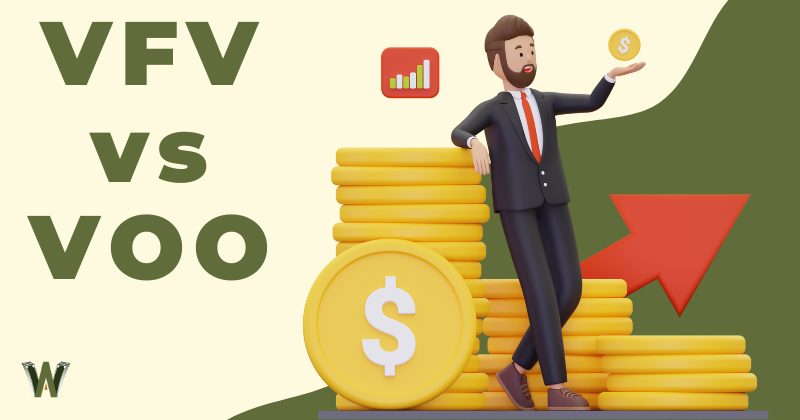The S&P 500 Index tracks the largest US companies by market capitalization and is an extremely popular index across the world. Investors are unable to invest directly in the index but rather have the option of purchasing an inexpensive fund that passively tracks it.
Investing $10,000 in an S&P 500 Index fund in 1985 would turn into $545,507 about 37 years later.
Vanguard offers both VFV and VOO, which are inexpensive index ETFs that track the S&P 500 index. I will compare both ETFs to see how they perform against each other in the following areas:
- Fees
- Performance
- Yield
- Length of track record and fund size
- Risk
| Differentiating feature | VFV | VOO |
| Inception date | November 2, 2012 | September 7, 2010 |
| Management expense ratio | 0.09% | 0.03% |
| Yield | 1.26% | 1.56% |
| Stock exchange | Toronto Stock Exchange | New York Stock Exchange |
I will outline VFV vs VOO and compare the two funds against each other.
US-Listed vs Canadian-Listed ETFs
One of the key differences between VOO and VFV is that one is US-listed while the other is listed on a Canadian exchange. They both look to track the same thing – the S&P 500 Index.
The VOO ETF is US-listed on the New York Stock Exchange, meaning that it has to be purchased in US dollars. Since it trades in US dollars, it does not reflect any currency impacts between the Canadian dollar and the US dollar. These impacts will be seen in your Canadian-denominated total returns.
The VFV ETF is Canadian-listed on the Toronto Stock Exchange, meaning that it has to be purchased in Canadian dollars.
The VFV ETF does reflect currency impacts between the Canadian dollar and the US dollar because it is unhedged.
This will also cause the VFV ETF to have a different return than the S&P 500 Index because it also contains the positive or negative return of currency fluctuations.
VFV vs VOO: Fees
If you are looking for inexpensive access to the S&P 500 index through a fund, both VFV and VOO allow you to invest using Canadian and US dollars respectively.
VFV is offered in Canada at a management expense ratio of 0.09%. VOO is offered in the US at a management expense ratio of 0.03%.
VOO and VFV are both available at a fraction of the fees that most mutual funds and ETFs are offered at.
Fees verdict – In terms of fees VOO is offered at a third of the cost of VFV, making it a much more cost-efficient option and the clear winner in this category.
VFV vs VOO: Performance
VFV and VOO should have significantly different long-term performance numbers due to currency fluctuations between the Canadian and the US dollars embedded within VFV’s returns.
Although both ETFs have different inception dates, their track record can be compared over periods of up to ten years. The VFV ETF has outperformed over the majority of timeframes:
| One Year | Three Year | Five Year | Ten Year | |
| Outperformer | VFV | VFV | VFV | VFV |
Keep in mind that over the last ten years, the US dollar has significantly appreciated in value against the Canadian dollar. This has helped the returns of VFV immensely.
Performance verdict – With the Canadian dollar severely depreciating against the US dollar (and helping VFV’s returns), VFV is the clear winner when it comes to overall performance.
VFV vs VOO: Yield
You would expect two ETFs that track the same index to offer almost identical yields. In reality, there is a difference in the yield offered by the two.
Both the VFV and VOO ETFs pay quarterly distributions.
The VFV ETF is currently paying a yield of 1.26% while VOO pays a yield of 1.56%.
Yield verdict – Although both ETFs pay investors distributions on a quarterly basis, the VOO ETF offers a higher yield and is the winner in this category.
VFV vs VOO: Length of Track Record and Fund Size
How large a fund is and how long ago it was launched are important elements that investors should look at before making an investment decision. Investors should try to look for large or very large funds that have been running for many years.
VFV and VOO both have long performance track records. VOO was launched on September 7, 2010, while VFV was launched on November 2, 2012.
VOO has a longer performance track record given that the fund’s inception date is further out.
When it comes to fund size, VOO overshadows VFV significantly. Although both ETFs are considered large, the size of a large ETF in Canada is much smaller than in the US (due to less available capital).
VFV currently has approximately $7 billion Canadian dollars in assets under management. VOO currently has just under $750 billion US dollars in assets, making it over 100 times bigger than VFV in size.
Fund size is more of an issue for newly-opened funds that have very little capital under management.
For funds that are very small, investment managers have to decide whether the fund can become profitable in the future (if it isn’t already) or if the fund should be closed down early. VFV and VOO are both free of any early-closure risks.
Length of track record and fund size verdict – With a longer performance track record and over 100 times more assets under management, VOO is the clear winner in this category.
VFV vs VOO: Risk
Risk is just as important (if not more important) to consider as performance. Both elements of a fund typically go hand-in-hand, with higher returns usually being offered at a higher risk.
Both ETFs and mutual funds usually have a risk rating assigned to them by their respective investment manager (in this case, Vanguard).
VFV in Canada is outlined as carrying a medium risk rating. With the US having different reporting standards, VOO is outlined as being moderate to aggressive in terms of risk. VOO has a risk rating of four out of a maximum of 5.
While it is difficult to compare the ratings between Canada and the US, the funds carry a very similar risk rating due to tracking the same investment (the S&P 500 Index).
The VFV ETF has the additional impact of currency risk, although this usually helps to reduce riskiness since the US dollar tends to appreciate during difficult market conditions.
Risk verdict – Although both VFV and VOO track the S&P 500, the VFV ETF should face less volatility due to currency exposure between the Canadian and US dollars. For this reason, the VFV ETF can actually be considered less risky and is the winner in this category.
Frequently Asked Questions
VFV vs VTI
Another frequent comparison is drawn between the VFV and the VTI ETFs. While the VFV ETF is Canadian-listed and tracks the S&P 500 Index, the VTI ETF is US-listed and tracks the total US stock market (including mid-cap and small-cap stocks).
Both ETFs are managed by Vanguard.
VFV vs VSP
VFV and VSP are two ETFs that are also frequently compared, both also offered by Vanguard.
They are both Canadian-listed and look to track the S&P 500 Index. VSP is the currency-hedged version of the VFV, meaning that it removes the impact of currency fluctuations between the Canadian and the US dollar.
VFV vs SPY
The SPY and VFV ETFs are also frequently compared as options for investing in the S&P 500 Index.
The VFV is Canadian-listed and the ETF’s return includes currency fluctuations between the Canadian and US dollars. It is an ETF offered by Vanguard in Canada.
The SPY ETF is US-listed and is offered by State Street Global Advisors. The SPY will not have any currency impacts between the Canadian and US dollars embedded in its return because it is a US dollar-denominated fund.
Our Final Verdict

With both the VFV and VOO ETFs having a similar mandate (tracking the S&P 500 Index), it is important to drill down into each fund’s specific features to determine which is the better choice out of the two.
Although VOO beats VFV in terms of many features (fees, size, length of track record, etc.), VFV’s outperformance over all time periods makes it a winner overall. The currency exposure between the US dollar and Canadian dollar also typically helps to reduce ETF downside during difficult market conditions.
If your decision to invest in the S&P 500 Index is influenced by currency, this will impact whether you purchase the VOO or VFV ETF.
If you would like to keep your investments in US dollars, you will have to buy the VOO ETF to gain exposure to the S&P 500 Index.
If you would like to keep your investments in Canadian dollars, you will have to buy the VFV ETF to gain exposure to the S&P 500 Index.
If you are a newer investor and are just getting started, make sure to read my outline on how to start investing in Canada in order to avoid numerous mistakes that beginner investors sometimes make.





